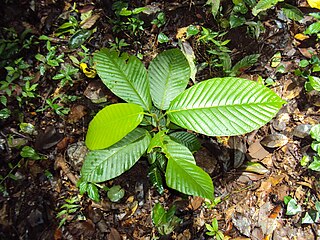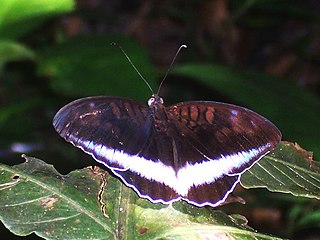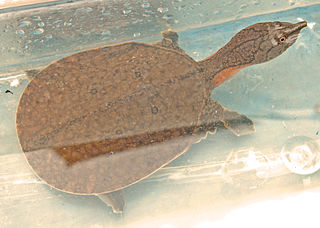
The geography of Malaysia includes both the physical and the human geography of Malaysia, a Southeast Asian country made up of two major landmasses separated by water—Peninsular Malaysia to the west and East Malaysia to the east—and numerous smaller islands that surround those landmasses. Peninsular Malaysia is on the southernmost part of the Malay Peninsula, south of Thailand, north of Singapore and east of the Indonesian island of Sumatra; East Malaysia comprises most of the northern part of Borneo, and shares land borders with Brunei to the north and Indonesian Borneo to the south.

Paphiopedilum, often called the Venus slipper, is a genus of the lady slipper orchid subfamily Cypripedioideae of the flowering plant family Orchidaceae. The genus comprises some 80 accepted taxa including several natural hybrids. The genus is native to Southeast Asia, the Indian Subcontinent, southern China, New Guinea and the Solomon and Bismarck Islands. The type species of this genus is Paphiopedilum insigne.

Dipterocarpus is a genus of flowering plants and the type genus of family Dipterocarpaceae.

The Malayan flat-shelled turtle is a species of turtle found in Southeast Asia.

The Limenitidinae are a subfamily of butterflies that includes the admirals and relatives. The common names of many species and genera reference military ranks or – namely the Adoliadini – titles of nobility, in reference to these butterflies' large size, bold patterns, and dashing flight. In particular, the light stripe running lengthwise across the wings of many Limenitidini has reminded earlier authors of officers' shoulder marks and epaulets.

Nepenthes angasanensis is a tropical pitcher plant species endemic to Sumatra, where it grows at an altitude of 1,400 metres (4,600 ft) to 3,100 metres (10,200 ft) above sea level. The status of this taxon is controversial as it is similar in morphology to N. mikei and N. tobaica. It has even been suggested that the taxon might represent a natural hybrid between N. densiflora and N. tobaica.
Gogana is a genus of moths of the family Drepanidae. The genus was erected by Francis Walker in 1866. There are currently about 15 described species, all of which are found on Borneo, but some of which also have ranges in Sumatra and Peninsular Malaysia. The larvae feed on palms.

Daphniphyllum is the sole genus in the flowering plant family Daphniphyllaceae and was described as a genus in 1826. The genus includes evergreen shrubs and trees mainly native to east and southeast Asia, but also found in the Indian Subcontinent and New Guinea.

Pantoporia sandaka, the extra lascar, is a species of nymphalid butterfly found in tropical and subtropical Asia.

The Malayan softshell turtle is a species of softshell turtle in the family Trionychidae. It is monotypic in its genus.

Barringtonia is a genus of flowering plants in the family Lecythidaceae first described as a genus with this name in 1775. It is native to Africa, southern Asia, Australia, and various islands of the Pacific and Indian Oceans. The genus name commemorates Daines Barrington.

Pholidocarpus is a genus of flowering plants in the family Arecaceae, native to Southeast Asia.

Payena is a genus of plants in the family Sapotaceae, described as a genus in 1844. It is native to Southeast Asia.

Dipodium, commonly known as hyacinth orchids, is a genus of about forty species of orchids native to tropical, subtropical and temperate regions of south-east Asia, New Guinea, the Pacific Islands and Australia. It includes both terrestrial and climbing species, some with leaves and some leafless, but all with large, often colourful flowers on tall flowering stems. It is the only genus of its alliance, Dipodium.

Homalomena is a genus of flowering plants in the family Araceae. Homalomena are found in southern Asia and the southwestern Pacific. Many Homalomena have a strong smell of anise. The name derives apparently from a mistranslated Malayan vernacular name, translated as homalos, meaning flat, and mene = moon.

Anuga is a genus of moths of the family Euteliidae. The genus was erected by Achille Guenée in 1852.

Peninsular Malaysia, historically known as Malaya, also known as West Malaysia or the "Malaysian Peninsula", is the western part of Malaysia that comprises the southern part of the Malay Peninsula on Mainland Southeast Asia and the nearby islands. Its area totals approximately 132,490 km2 (51,150 sq mi), which is nearly 40% of the total area of the country; the other 60% is in East Malaysia on the island of Borneo.

Nepenthes of Sumatra and Peninsular Malaysia is a monograph by Charles Clarke on the tropical pitcher plants of Sumatra, Peninsular Malaysia, and their minor surrounding islands. It was published in 2001 by Natural History Publications (Borneo). Clarke described it as "intermediate between an ecological monograph and a taxonomic one".

Pantoporia is a genus of Asian butterflies sometimes called the lascars. They are predominantly with striped patterns of orange and black.

Pantoporia dindinga, the greyline lascar, is a species of nymphalid butterfly found in Asia, where it ranges from Burma to Peninsular Malaysia, Bangka, Borneo and possibly Sumatra.



















